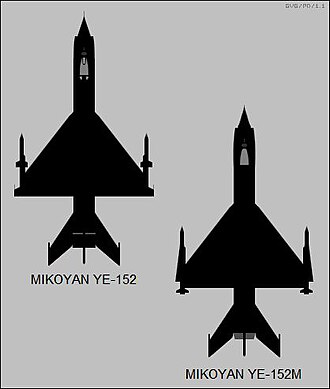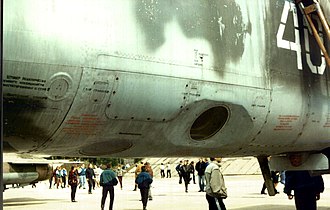

During the Cold War, Soviet Air Defence Forces, PVO (not to be confused with Soviet Air Force, VVS) was given the task of strategic air defence of the USSR. This meant not only dealing with accidental border violations, but more importantly defending the vast airspace of the USSR against US reconnaissance aircraft and strategic bombers carrying free-fall nuclear bombs. The performance of these types of aircraft was steadily improved. In the late 1950s, the very high altitude overflights of Soviet territory by the Lockheed U-2 revealed the need for a higher altitude interceptor aircraft than available at that time.

The subsonic Boeing B-47 Stratojet and Boeing B-52 Stratofortress strategic bombers were followed by the Mach 2 Convair B-58 Hustler, with the Mach 3 North American B-70 Valkyrie on the drawing board at that time. A major upgrade in the PVO defence system was required, and, at the start of 1958, a requirement was issued for manned interceptors capable of reaching 3,000 km/h (1,600 kn) and heights of up to 27 km (89,000 ft). Mikoyan and Sukhoi responded.
The Mikoyan-Gurevich OKB had been working on a series of interceptors during the second half of the 1950s: the I-1, I-3U, I-7U, I-75, Ye-150, Ye-150A, Ye-152, Ye-152A, Ye-152P, and Ye-152M. The Ye-150 was noteworthy because it was built specifically to test the Tumansky R-15 engine, two of which would later be used for the MiG-25. This led to Ye-152, alternatively known as Ye-166, which set several world records. The Ye-152M (converted from one of the two Ye-152 aircraft) was intended to be the definite heavy interceptor design. But before it was finished, the PVO had selected the Tupolev Tu-128. As the work on the MiG-25 was well under way, the single-engine Ye-152M was abandoned.
Work on the new Soviet interceptor that became the MiG-25 started in mid-1959, a year before Soviet intelligence learned of the American Mach 3 A-12 reconnaissance aircraft. It is not clear if the design was influenced by the American A-5 Vigilante.
The design bureau studied several possible layouts for the new aircraft. One had the engines located side by side, as on the MiG-19. The second had a stepped arrangement with one engine amidships, with exhaust under the fuselage, and another in the aft fuselage. The third project had an engine arrangement similar to that of the English Electric Lightning, with two engines stacked vertically. Options two and three were both rejected because the size of the engines meant that either of them would result in a very tall aircraft, which would complicate maintenance.
The idea of placing the engines in underwing nacelles was also rejected because of the dangers of any thrust asymmetry during flight. Having decided on engine configuration, there was thought of giving the machine variable-sweep wings and a second crew member, a navigator. Variable geometry would improve manoeuvrability at subsonic speed, but at the cost of decreased fuel tank capacity. Because the reconnaissance aircraft would operate at high speed and high altitude, the idea was soon dropped. Another interesting but impractical idea was to improve the field performance using two RD36-35 lift-jets. Vertical takeoff and landing would allow for use of damaged runways during wartime and was studied on both sides of the Iron Curtain. The perennial problem with engines dedicated to vertical lift is they become mere dead weight in horizontal flight and also occupy space in the airframe needed for fuel. The MiG interceptor would need all the fuel it could get, so the idea was abandoned.

The first prototype was a reconnaissance variant, designated Ye-155-R1, that made its first flight on 6 March 1964. It had some characteristics that were unique to that prototype, and some of these were visually very evident: the wings had fixed wingtip tanks with a 600 L (160 US gal) capacity, to which small winglets were attached for stability purposes, but when it was found that fuel sloshing around in the tanks caused vibrations, they were eliminated. The aircraft also had attachments for movable foreplanes, canards, to help with pitch control at high speed (provisions for canards had previously been installed, but not used, on the Ye-152P).
The first flight of the interceptor prototype, Ye-155-P1, took place on 9 September 1964. Development of the MiG-25, which represented a major step forward in Soviet aerodynamics, engineering and metallurgy, took several more years to complete.
On 9 July 1967, the new aircraft was first shown to the public at the Domodedovo air show, with four prototypes (three fighters and a reconnaissance aircraft) making a flypast
The Mikoyan-Gurevich design bureau soon realized that the performance of the new aircraft gave it great potential to set new flight records. In addition to their normal duties, the prototypes Ye-155-P1, Ye-155-R1, Ye-155-R3 were made lighter by removing some unneeded equipment and were used for these attempts. Under Federation Aeronautique Internationale (FAI) classification, the Ye-155 type belonged to class C1 (III), which specifies jet-powered land planes with unlimited maximum take-off weight. Records set included:
In all, 29 records were claimed, of which seven were all-time world records for time to height, altitudes of 20,000 m (66,000 ft) and higher, and speed. Several records still stand.
Because of the thermal stresses incurred in flight above Mach 2, the Mikoyan-Gurevich OKB had difficulties choosing what materials to use for the aircraft. They had to use E-2 heat-resistant Plexiglas for the canopy and high-strength stainless steel for the wings and fuselage. Using titanium rather than steel would have been ideal, but it was expensive and difficult to work with. The problem of cracks in welded titanium structures with thin walls could not be solved, so the heavier nickel steel was used instead. It cost far less than titanium and allowed for welding, along with heat-resistant seals. The MiG-25 was constructed from 80% nickel-steel alloy, 11% aluminium, and 9% titanium. The steel components were formed by a combination of spot welding, automatic machine welding, and hand arc welding methods.
Initially, the interceptor version was equipped with the TL-25 Smerch-A (also referred to as Product 720) radar, a development of the system carried by the earlier Tu-128. While powerful and thus long-ranged and resistant to jamming, the system—due to the age of its design and its intended purpose (tracking and targeting high- and fast-flying US bombers and reconnaissance aircraft)—lacked look-down/shoot-down capability, which limited its effectiveness against low-flying targets. (This is one of the reasons why it was replaced with the Mikoyan-Gurevich MiG-31, whose Zaslon radar has that capability.) By the time the MiG-25 entered service in 1969, this was a serious shortcoming, as strategic bombing doctrine was shifting towards low-level penetration of enemy territory. After Belenko's defection to Japan exposed this flaw to the West, a government decree issued on 4 November 1976 called for urgent development of a more advanced radar. This resulted in the pulse-Doppler radar Sapphire-25 system fitted to the MiG-25PD variant.
As an interceptor, typical armament includes four R-40 long-range air-to-air missiles, each fitted with either an infrared seeker (R-40T/TD) or a semi-active radar homing seeker (R-40R/RD) and a maximum range of 35–60 km (22–37 mi) against a high-flying target on a collision course. A fuel tank could be suspended under the fuselage. The aircraft could carry unguided gravity bombs to fulfill a rudimentary strike role by using a delivery system developed for nuclear weapons. As the bombs would weigh no more and incur no more drag than its regular load of R-40 missiles, its performance was not impaired, leading to some impressive bombing feats; when released at an altitude of 20,000 m (66,000 ft) and a speed above Mach 2, a 500 kg (1,100 lb) bomb would have a range of several tens of kilometres.
The MiG-25 was theoretically capable of a maximum speed exceeding Mach 3 and a ceiling of 27 km (89,000 ft). Its high speed was problematic: although sufficient thrust was available to reach Mach 3.2, a limit of Mach 2.83 had to be imposed as the engines tended to overspeed and overheat at higher air speeds, possibly damaging them beyond repair.
The design cruising speed is Mach 2.35 (2,500 km/h) with partial afterburner in operation. The maximum speed of Mach 2.83 (3,000 km/h) is allowed to maintain no more than 5 minutes due to the danger of overheating of the airframe and fuel in the tanks. When the airframe temperature reaches 290 °C (554 °F), the warning lamp lights up, and the pilot must reduce airspeed. The use of a partial afterburner and a cruising flight altitude 19,000–21,000 m (62,000–69,000 ft) makes it possible to have a range only 230 km (140 mi) less than when flying Mach 0.9 at altitudes 9,000–10,000 m (30,000–33,000 ft). The maximum altitude of flight without an afterburner in operation is 12,000 m (39,000 ft). The poor fuel consumption in the subsonic regime, and hence range, is due to the engines having extremely low pressure ratio of just 4.75 at subsonic speeds. The specific fuel consumption (SFC) of the engines is 1.12lb/(h·lbf) in cruise and 2.45lb/(h·lbf) with afterburners. For comparison purposes, this is 50% worse in cruise than the first generation of F100 engines from the F-15 Eagle, but the SFC with afterburners is actually nearly equal, despite the F100 being a far newer engine design.

Full-scale production of the MiG-25R ("Foxbat-B") began in 1969 at the Gorkii aircraft factory (Plant No. 21). The MiG-25P ("Foxbat-A") followed in 1971, and 460 of this variant were built until production ended in 1982. The improved PD variant that replaced it was built from 1978 till 1984, with 104 aircraft completed. Subsequently, the Gorkii factory switched over production to the new MiG-31.

Inaccurate intelligence analysis caused the West initially to believe the MiG-25 was an agile air-combat fighter rather than an interceptor. In response, the United States started a new program, which resulted in the McDonnell Douglas F-15 Eagle. NATO obtained a better understanding of the MiG-25's capabilities on 6 September 1976, when a Soviet Air Defence Forces pilot, Lt. Viktor Belenko, defected, landing his MiG-25P at Hakodate Airport in Japan. The pilot overshot the runway on landing and damaged the front landing gear. Despite Soviet protests, the Japanese invited U.S. Air Force personnel to investigate the aircraft. On 25 September, it was moved by a C-5A transport to a base in central Japan, where it was carefully dismantled and analyzed. After 67 days, the aircraft was returned by ship to the Soviets, in pieces. The aircraft was reassembled and is now on display at the Sokol plant in Nizhny Novgorod.
The analysis, based on technical manuals and ground tests of its engines and avionics, revealed unusual technical information:
As the result of Belenko's defection and the compromise of the MiG-25P's radar and missile systems, beginning in 1976, the Soviets developed an updated version with a new fire control system, the MiG-25PD ("Foxbat-E"). The MiG-25PD replaced the Smerch-A radar of the MiG-25P with the Saphir-25, based on the Mig-23's Saphir-23, supplemented by an Infrared search and track (IRST) system. The ability of carry R-60 air-to-air missiles was added. A total of 104 MiG-25PDs were built from 1978 to 1984, while existing MiG-25Ps were modified to a similar standard to the PD as the MiG-255PDS.
Work was also carried out to improve the MiG-25's performance, with a revised version of the R15 engine, the R15BF2-300, designed with an extra compression stage and running at higher temperatures to give greater power and better fuel consumption. A MiG-25P was fitted with the new engines, with testing of the modified aircraft, unofficially known as the MiG-25M (Ye-155M) beginning in 1974. Planned production aircraft would have received improved radar and armament, but production orders never followed, as the coming MiG-31 showed more promise. Three MiG-25RB reconnaissance/strike aircraft were also modified with the R15BF2-300, which were used to set a series of time-to-height world records (under the designation Ye-266M) on 17 May 1975, and two altitude world records in 1977.